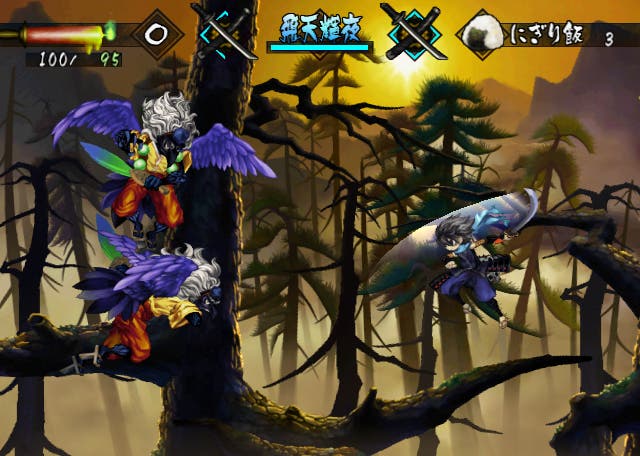Muramasa: The Demon Blade
A holiday romance.
Whenever you get back from a trade event, everyone asks what the best game was. For this year's Tokyo Game Show, it's a surprisingly difficult question to answer.
Biohazard 5 left a huge impression on many, but veterans of Leipzig and E3 had seen it all before under the Resident Evil banner. Second-string JRPGs jostled for attention: White Knight Chronicles intrigued, Last Remnant and Star Ocean helped Microsoft towards its best Tokyo showing to date. Square Enix displayed a plethora of handheld variations on franchise themes, but its looming black stand ultimately seemed like a monolithic vacuum where Final Fantasy XIII and Dragon Quest IX should have been.
SEGA's Bayonetta and Yakuza 3 dazzled, but their wild and seedy glamour remained frustratingly out of reach on cinema screens. The local punters, meanwhile, voted with their tired, queue-hardened feet, mobbing Capcom's stand for Monster Hunter Tri, but that game was a learning process for most of us gaijin (one that cosmopolitan Keza will help us all through soon).
That's Tokyo. The big hitters are just set-dressing in a way, and the game of the show is more likely to be a love affair, a personal thing. It's the game you'd never know about otherwise, the game that stays with you through the noise and the jetlag, the game you stumble upon when hunting the baffling, blaring stands for the one bit of madness that makes sense. Ellie and Let's Tap found each other and made beautiful, cross-cultural, box-banging music. I swooned at the feet of Muramasa: The Demon Blade.

It's hardly surprising. Vanillaware's 2D hackandslash for Wii - coming to Europe next year, courtesy of Rising Star - is a real heart-breaker. As you'd expect from the developers of Odin Sphere, the action is fashioned out of huge, exquisite, hand-painted sprites set against lush parallax backdrops. But Muramasa's strictly traditional approach to its Japanese mythological setting - in the mystical Genroku era - has inspired a pure lyricism from the artists in place of Odin Sphere's fanatically detailed whimsy. If anything, it's even more beautiful.
You can watch the most of the show-floor demo we played on Eurogamer TV. It doesn't reflect the rhythm and style of the final game, which will likely feature longer stages, and will certainly contain a lot more in the way of story and role-playing elements. It was more a series of combat vignettes, a quick trot through a roster of enemy types, boss encounters and locations. Every stage was over in under a minute.
It was barely enough to take in the sights. The colour is unbelievable, luminous and warm in a way that couldn't be achieved in lit polygons. Waves scroll and grasses waver like stop-motion watercolours. The enemies are a parade of bewildering, mystical golems conjured out of branches and feathers and hair; their flickering, unstable forms are impossible to pin down as they flit around the screen, but their personalities are charming and menacing in equal measure. We battled a giant tin knight in an autumnal cornfield, bird-men in the branches of a mountain forest, whirling twin parasol-monsters at a temple, a gurning demon under moonlit cherry-blossom.
In this demo, Muramasa was extremely fast and forgiving to play. The game can be played either using a remote/nunchuk pair or the classic controller. Your hero - a male ninja or female kunoichi, equally pretty and nimble - darts around on the stick, with multiple jumps - practically flight - possible with upward flicks of the stick. You can stay airborne almost infinitely by juggling jumps with sword slashes on A, as long as there are enough monsters up there to kill.

The A button can be combined with a downward flick for a slam, and holding down B triggers a prolonged special move such as an upward spin attack, or staggered series of super-slams. What this move is depends on which sword you're wielding - and it requires your sword to have enough integrity.
You find yourself watching your two swords' health more closely than your own in Muramasa. They're quite rapidly depleted with use, they do break, and you need at least half your sword-health to use a special move. They repair when not in use, so you need to carefully rotate the two - switching between them on C, with a crisp, action-snapping pause - to ensure you have the right special available at the right moment. That's for optimum play, mind - you can get through the demo, at least, fairly painlessly with no strategic forethought at all. Your own health is recharged from the souls of dead enemies, i.e. all the time.
In this form Muramasa was simple, balanced, extremely rapid and thoroughly satisfying to play. It seems to eschew convoluted combos or elaborate action-RPG mechanics for hypnotically powerful rhythms, the see-saw poise of the sword system, and interesting enemy attack patterns. Whether this is representative of the game as a whole - and if it is, whether it has any longevity or depth whatsoever - is at this point impossible to say. Either way, a pure action game of this craftsmanlike quality will be very welcome on Wii.
Simon's eventual disenchantment with Odin Sphere's repetition and difficulty should serve as stern warning for future of this love affair. Like all young lovers though, we're deaf to good sense. Muramasa is gorgeous, mysterious, fast and graceful - and we saw her first. Whatever happens, we'll always have Tokyo.

